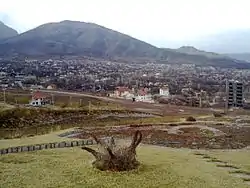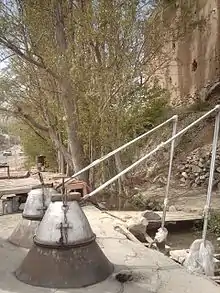Qamsar
Persian: قمصر | |
|---|---|
City | |
 View from the city of Qamsar | |
 Qamsar | |
| Coordinates: 33°45′05″N 51°25′57″E / 33.75139°N 51.43250°E[1] | |
| Country | Iran |
| Province | Isfahan |
| County | Kashan |
| District | Qamsar |
| Population (2016)[2] | |
| • Total | 3,877 |
| Time zone | UTC+3:30 (IRST) |
Qamsar (Persian: قمصر, also Qamşar, Ghamsar and Kamsār)[3] is a city in, and the capital of, Qamsar District of Kashan County, Isfahan province, Iran. The district is 15 km south of Kashan.
At the 2006 census, its population was 3,566 in 1,048 households.[4] The following census in 2011 counted 3,410 people in 1,066 households.[5] The latest census in 2016 showed a population of 3,877 people in 1,271 households.[2]
From the 13th century and possibly considerably earlier, cobalt was mined near Qamsar. The metal oxide was exported all over the Muslim world for use as the cobalt blue pigment in the decoration of pottery. It is possible that the cobalt ore was also exported to China.[6] In 1301 Abū'l-Qāsim, who came from a family of tilemakers based in Kashan, wrote a treatise on the manufacture of fritware ceramics in which he mentions the village as a source of cobalt ore.[7][8]
Albert Houtum-Schindler visited the village at the end of the 19th century when Qamsar was "a large and flourishing village of about three hundred houses with extensive gardens with fine roses used for the manufacture of rosewater."[9] He described the processing and marketing of the cobalt-containing ore.[9]

Ghamsar is host to one of the biggest festivals of Iran called Golabgiri to celebrate the production of rose water in spring.
References
- ↑ OpenStreetMap contributors (16 June 2023). "Qamsar, Kashan County" (Map). OpenStreetMap. Retrieved 16 June 2023.
- 1 2 "Census of the Islamic Republic of Iran, 1395 (2016)". AMAR (in Persian). The Statistical Center of Iran. p. 10. Archived from the original (Excel) on 19 October 2020. Retrieved 19 December 2022.
- ↑ Qamsar can be found at GEOnet Names Server, at this link, by opening the Advanced Search box, entering "-3079465" in the "Unique Feature Id" form, and clicking on "Search Database".
- ↑ "Census of the Islamic Republic of Iran, 1385 (2006)". AMAR (in Persian). The Statistical Center of Iran. p. 10. Archived from the original (Excel) on 20 September 2011. Retrieved 25 September 2022.
- ↑ "Census of the Islamic Republic of Iran, 1390 (2011)" (Excel). Iran Data Portal (in Persian). The Statistical Center of Iran. p. 10. Retrieved 19 December 2022.
- ↑ Kerr, Rose; Wood, Nigel (2004). Science and Civilisation in China Volume 5. Part 12, Ceramic Technology. Cambridge: Cambridge University Press. pp. 658–692. ISBN 0-521-83833-9.
- ↑ Allan, J.W. (1973). "Abū'l-Qāsim's treatise on ceramics". Iran. 11: 111–120. doi:10.2307/4300488. JSTOR 4300488. Archived from the original on 23 March 2012. Retrieved 13 October 2011.
- ↑ Matin, Moujan; Pollard, Mark (2015). "Historical accounts of cobalt ore processing from the Kashan mine, Iran". Iran: Journal of the British Institute of Persian Studies. 53 (1): 171–183. doi:10.1080/05786967.2015.11834755. S2CID 117129519.
- 1 2 Houtum-Schindler, Albert (1897). Eastern Persian Irak. London: Royal Geographical Society, J. Murray. p. 114. Available from Google books but full view only available in the US.
Further reading
- Matin, M.; Pollard, A.M. (2017). "From ore to pigment: a description of the minerals and an experimental study of cobalt ore processing from the Kāshān mine, Iran". Archaeometry. 59 (4): 731–746. doi:10.1111/arcm.12272.
